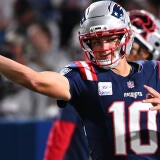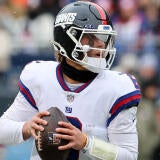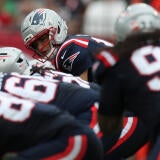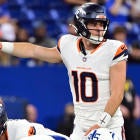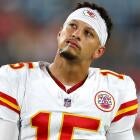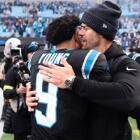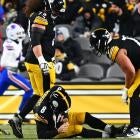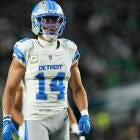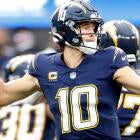What's happened to passing offenses in the NFL? Breaking down the possible reasons for dip in QB efficiency
Examining the striking early-season dip in passing efficiency in the NFL

The NFL's two-decade long bull market of passing is experiencing a mini crash at the start of the 2024 season. You've seen the stats and have watched the games. Interceptions are up, passing yards per game are down, and we enter Week 3 with the fewest touchdown passes through two weeks in ages.
What gives? What's happening with NFL passing offenses? What's written below is not gospel. I felt compelled to write on this fascinating development uniquely positioned as a draft analyst and someone who has watched every drop back of all first- and second-year quarterbacks in 2019, 2021, 2022, 2023 and to date this season.
Naturally, I have to narrow the focus on the quarterbacks, those responsible for moving the football through the air, the ones with the "most important player on the field" label in the NFL.
Before I begin, let's set aside any nostalgia for how quarterbacks used to be developed. The system has never been perfect. Top picks have always busted, and the league has never featured a surplus of outstanding quarterback play.
But why the passing-efficiency dip now? Over the past decade or so, offenses in college football have gotten more "schemed-up," meaning, more bubble screens, RPOs, and easy, high-percentage, first-read throws for its quarterbacks.
Since the dawn of the forward pass, every scheme's primary aim has been to get the first read open. Over the past decade, those first reads have come on shorter throws with more space around them. We can thank the proliferation of spread alignments and a growing emphasis on throwing the football for that.
A major reason for the shift to "schemed-up" offenses is the rise of athletic quarterbacks. They've revolutionized the game, not just at the college level, but across all levels of football.
How are these two elements related? In essence, (most) college offenses of today -- and the last decade -- attempt to get that first read open. If it's not, the quarterback automatically clicking into scramble mode is met with more leniency than ever. Heck, at some schools, that immediate reaction is probably encouraged.
Critically to my point here -- in many cases in college, that system really works.
Ask Johnny Manziel, Marcus Mariota, Jalen Hurts, and many others, including current college quarterback Thomas Castellanos of Boston College, who's been awesome through three games.
That is not to insult all of those quarterbacks, insinuating they were strictly one-read-then-run passers. They got through their progressions at times, but doing so wasn't a staple of their games nor their offenses at large.
But in college, they can throw shallow crosses, tunnel/bubble screens, RPOs, check downs, and an occasional go-ball to a future first-round pick with a future seventh-round pick in coverage -- or, when the talent edge is even more evident, to a future fifth-round pick with a future insurance salesman in coverage -- and flourish on Saturdays.
Given some of the athletic specimens at quarterback college football has sent to the NFL over the last 10 years, that ideology can work in the NFL. But -- and this is paramount -- NFL defenses have had ample time to adjust. Coordinators have devised schemes to directly combat spread concepts, easy, first-read throws underneath, and dual-threat quarterbacks. This shift has drastically altered team-building on that side of the ball, too. Rosters have now long been constructed to be lighter, faster, with more defensive backs on the field. Every team has at least one super-sudden, feisty, and fast nickel cornerback. How long have we all be talking about nickel corners as a starting position? About 10 years now.
These new-age defenses will "gladly" allow 50-100 yards rushing from a quarterback if the tradeoff is limited aerial production from the opposing offense, which remains the most efficient way to move the football. To achieve this, we've seen more two-high safety looks, linebackers who weigh no more than 230 pounds and can cover, five and sometimes six defensive backs on the field, and blurred lines between strong and free safety distinctions.
Because those very decorated college quarterbacks don't have as much experience and schooling gliding through reads from within the confines of the pocket, it's silly to assume they'll suddenly become proficient doing so in the NFL when everything is noticeably faster.
Therefore, the majority of offensive coordinators cater to their quarterback's strengths. They try to tailor the scheme to fit their player's talents. The opposite has become the cardinal sin of coordinating. And all that is sensible.
Except for this "college" style of offense to work in the NFL, a team needs a few rather scarce things -- an absolute freak at quarterback and/or a ridiculously talented cast around the quarterback. And it's simply much harder to build that kind of talent advantage in the NFL than it is in college. Even if an NFL team does get that advantage, keeping it intact is essentially unfeasible for a multitude of reasons.
Many of the quarterbacks who've entered the league the past 5 to 7 years were not asked to make many difficult throws/reads but were still productive enough in college to be deemed NFL caliber. Then in the NFL, all those shallow crosses, tunnel/bubble screens, RPOs, and check downs don't turn into splash plays anywhere close to as often. The defensive schemes are equipped to stop them, and the defenders are just too damn fast. Subsequently, those quarterbacks encounter third-and-long scenarios more ever. Then exotic blitzes and coverages appear. And those QBs are, at least initially, in over their heads.
We've seen this transpire with Bryce Young, Mac Jones, Daniel Jones, Hurts, Justin Fields, Zach Wilson, Desmond Ridder, Anthony Richardson, and all the rookies to date.
For some, developing enough assertiveness to make challenging throws -- that transcend the scheme and the defense it's facing -- will come with time (if they're given enough time). Or, they must lean on elite-level physical traits or land in a stellar environment rich with skill-position and offensive line talent.
Nearly half of Week 1 starters (15 of 32) were passers selected in one of the past five drafts. Justin Herbert is the only one of that group who entered the year with more than 2,000 career regular-season attempts. Which mostly speaks to how we've gotten to where we are today, after two weeks of relatively dismal aggregate quarterback play in the NFL. But it's not entirely due to young, inexperienced passers from simplified college systems that aren't nearly as effective on Sundays.
There are many factors at play here, but I believe it to mostly boil down to these elements -- the way quarterbacks are coached in college, their collectively magnificent athletic gifts, and NFL defenses now ready to stop the schemed-up offenses.
Passing efficiency in the NFL will return, yet this bad start to 2024 may signal a breaking point. As the league evolves, the task at hand for GMs will be to evolve with it, tweaking their approach to how they evaluate quarterbacks, prioritizing a passer's skills apart from those easy throws in space. For coaches, the challenge will be how they develop quarterbacks to advance beyond the schemed-up offense to prepare them for real life in the NFL.


